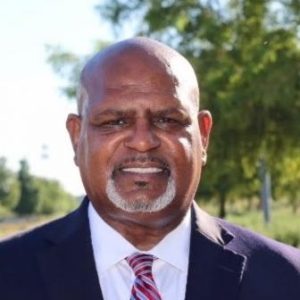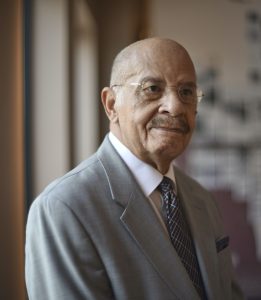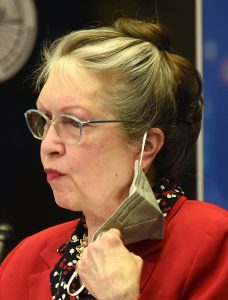
By Ryan Michaels
The Birmingham Times
When Birmingham City Councilor J.T. Moore first moved into the South Woodlawn neighborhood with his wife, Alycia, in 2013, he was already known in the community.
Vanessa Jones, a neighbor, knew Moore from his time volunteering at Woodlawn High School and urged the Moores to participate in the neighborhood association (NA). Soon thereafter, Moore and his wife attended their first neighborhood meeting—and immediately saw the value of the group.
“I learned about the history of different things that had taken place [in the neighborhood], but then I also learned about current events and things that were happening around me, which I might not have learned about if I hadn’t come to the [NA],” said Moore, first elected to the council in 2021.
The most ideal NA, according to Moore is “a collection of residents that have an idea of the direction that they want to take their neighborhood.”
At one time, Birmingham’s NA system was considered a “model program” which had a significant impact on the direction of city governance, but it has seen better days, according to numerous former and current city leaders.
In interviews with The Birmingham Times over the past two months, multiple neighborhood, City Council and former mayoral leaders have said a lack of training and resources, as well as apathy from residents, has left NAs with less power and influence than they’ve had in previous decades.
Roderick Royal, who served on the Birmingham City Council from 2001 to 2013, and even had a two-month stint as acting mayor from 2009 until 2010, said some current neighborhood officers don’t have the same kind of political knowledge that older ones did.
“[Previously], I think [neighborhood officers] were more civically trained, and I think we need a return to that kind of training,” said Royal, adding that the institution of NAs has withered partly because politicians in the city have garnered support from the organizations with petty stuff.
“A Seat at City Hall”

According to Steven Hoyt, who served on the Birmingham City Council from 2005 to 2021, “pockets” of neighborhoods and communities have a “seat at City Hall,” but most residents don’t have the voice they once did.
“I think they’re pretty much being dictated to as to what they can and cannot do, when neighborhood officers used to be informed about what they could and could not,” Hoyt said.
When running for council in 2005, Hoyt felt it was critical to seek the support of neighborhood leaders. “I had to go and kiss the rings in various neighborhoods. I don’t even think they have to do that anymore. … I just don’t see the level of influence. I don’t see the level of involvement, collectively,” he said.
William Harden, vice president of the Citizens Advisory Board (CAB), said active NAs are bringing about successes for their communities, but many are not functional.
“It’s very important that all 99 [city neighborhoods] become active … because they do have a very specific purpose in kind of driving neighborhood-centric ideas through and toward the city,” he said. “Without that ability and without those neighborhoods functioning, it takes away a lot of neighborhood input into the things that happen in the city.”
Harden pointed out that the deaths of some neighborhood officers while in office has created a void in leadership. Additionally, he said some people have simply checked out of being involved in neighborhood governance for a number of reasons.

“There is some apathy within the neighborhoods, and it’s simply because people who have been in their existing neighborhoods for an extended period of time have been so used to being neglected that they tend to not always see the real purpose and the need for those neighborhoods,” Harden said.
Alice Williams, deputy director of Community Resource Services, a division of city government that administers the system of NAs and Community Advisory Committees (CACs), said the organizations were a “catalyst” to give residents access to city government, but more people now have access to city government directly. Furthermore, a lack of succession planning has hurt NAs, she said.
“The older people that have participated in this [system] kind of died out. The torch wasn’t passed as much as we would have liked to other folks who were interested in serving, so I think it’s shifted a little bit now,” she said.
The System Is Born
The formation of NAs can be traced back to 1972, when the city of Birmingham established its Community Development Department (CDD), initially created to consolidate city services under one umbrella and to better manage federal grants.
A few years later, in response to guidelines for the newly established federal Community Development Block Grant program in 1974, then-Birmingham Mayor George Seibels proposed the first version of the Citizen Participation Plan (CPP). The plan, which underwent significant revision throughout 1974, established Birmingham’s current three-tiered system of resident participation, made up of neighborhood associations, CACs, and the CAB, respectively.
Since the first election in November 1974, the system has grown to include 99 NAs, from which 23 CAC presidents are elected. Those presidents go on to form the CAB, the highest level of the system.
When implemented in the mid-1970s, the CPP was considered a “model program,” according to former Mayor Richard Arrington, who served on the City Council from 1973 to 1979, when he was elected the city’s first Black mayor. Arrington argues that the CPP is second only to the national Voting Rights Act of 1965 in the level of political strength that Black residents of Birmingham had at the time.

“Every community was organized, Black and white, and the Black communities especially, like North Birmingham and West End,” he said. “All of the Black communities were better organized, as a result of that block grant program, than they’d ever been before. It was easy to do because we had, of course, segregated communities.”
Bond issues to build large capital projects were successful only because of the political strength of Black residents in Birmingham, Arrington added: “Every bond issue that was passed, passed on the strength of the vote from the Black communities. Every one of those bond issues, … every one of them failed in the predominantly white block.”
According to results from the most recent neighborhood election, which was held in October 2022, 10 neighborhoods don’t have any elected officers. During Arrington’s time as an elected official, he said, weekly neighborhood meetings were “well-attended and well-organized.”
“Black communities would oftentimes have representatives from their neighborhood down at City Hall, talking about what was on the agenda and what impacted them. They really had a political voice,” the former mayor added.
Voice and Attention
According to Councilor Moore, the ideal NA gives voice and attention to young and older residents of neighborhoods, Moore said. Under the CPP, residents as young as 16 can vote on NA matters.
NAs also should serve as the home group for organizing to address issues, such as blight elimination, he said. When problem properties are identified, neighborhood residents can figure out all the relevant information—property owners, tax delinquency status, the technical bounds of the property—and present that information to leaders like their city councilor.
Moreover, NAs should serve as community-building groups.

“The time of just going inside your house, going to sleep, waking up, leaving out, going to work, and then coming back, doing the same thing over and over again, without talking to your neighbors or engaging the people that are right next to you is over. We need each other,” Moore said.
The primary goal of NAs should be to increase engagement among residents, something many NAs are currently working on.
“I think a lot of [NAs] have actually changed leadership, so you have some that are kind of getting their feet under them and really doing their part to organize their residents and share information,” Moore said.
Harden, of the CAB, said neighborhood officers still have an important say at City Hall.
“Granted, even with that input, [the city doesn’t] always listen,” he said. “[Nonetheless], it definitely would be very detrimental without those neighborhoods being involved in that process, [without] having those officers speaking up and advocating for the neighborhoods with the council, with the city, all those departments. So, it’s important that we do have those active neighborhoods.”
The Power of Neighborhoods
Doris Powell, former president of the Fountain Heights NA, is a clear example of neighborhood leadership, someone who used her voice to affect change, Royal said.
Powell is credited for rallying support for the construction of 25 affordable homes in her community, as well as for significant improvements to the then-dilapidated Fountain Heights Recreation Center. When Powell died in 2012, then-Mayor William Bell said losing Powell hurt the whole city.
“It’s going to be a great loss not only to the Fountain Heights neighborhood but also to the entire city. Her last dying breath was given in service to the community,” Bell told AL.com in 2012.
Ultimately, advocacy and cooperation like Powell’s are the two keys to successful NAs, said Royal, who also has served as secretary of the East Thomas NA. Earlier in his neighborhood involvement, elected officers would attend local “conferences,” where they would learn about city communication routes and various city departments, said Royal.
While neighborhoods citywide can see improvement, it’s important that the talent within NAs and CACs be recognized and used.
“What [residents] ought to do … is capitalize on the talent that’s there and make sure that talent is developed and well-trained. It could be a breeding ground for future leaders,” he said.
“Insider Information”
If anyone knows about NAs as a training ground for elected officials, it would be City Councilor Valerie Abbott. Before beginning her tenure on the council in 2001, she served previously as president of the Glen Iris NA and the Southside CAC.
Abbott believes the CPP is “fabulous,” but it has been somewhat neglected by city government. “I know people in other cities that surround us say, ‘Wow, we don’t have anything like that [neighborhood] voice in city government.’ … I think it’s a great system, but I think you have to nurture it, and you have to keep trying to keep people’s enthusiasm up,” she said.
When Abbott first got involved with neighborhood work, she relied on her community resource representative (CRR) to interact with City Hall. CRRs, Abbott said, help residents with all sorts of useful “insider information.”

“They would share information—who to go to in a department, for what purposes,” she said. “[They would let you know] who to talk to if, say, you want to get your sewer fixed [or] you want to know who’s in charge of demolitions.”
Abbott has seen significantly less of CRRs in her neighborhood and notes that there are fewer of them than there were in previous decades.
According to Williams, deputy director of Community Resource Services, there are currently six CRRs in the city. Each of those is assigned to a certain number of Birmingham’s 23 communities instead of being assigned directly to specific neighborhoods. This arrangement, according to Abbott, leaves neighborhood officers without as much guidance as in years past.
“[Today], people don’t get that handholding — as I call it that — that they used to get when they had insiders at City Hall who knew how everything worked and could advise them how to approach their projects and how to get things done,” the councilor said.
Gaining Useful Knowledge
In addition to serving as liaisons between neighborhood officers and city government, CRRs serve as administrators for the various projects that NAs put together, said Williams, who is trying to increase staffing in the Community Resources Services division. The smaller number of CRRs is reflective of the city’s population, she added, which has been on the decline since the 1960s.
Williams also pointed to the Academy of Civic Engagement (ACE), an annual city initiative that allows residents to learn about all aspects of city government and their place in it, as a key resource for residents to gain useful knowledge about how to lead their neighborhoods.
The city now offers more training than ever to current neighborhood officers. Before Williams was deputy director of the division, the city offered annual training only after swearing in neighborhood officers. Now, the city offers about three to four training sessions every year. The rub is that some neighborhood officers don’t take the city up on that offer.
“This is a volunteer position,” said Williams. “Although we say we require [the training], … it takes two levels of communication to make people understand that this is something that’s important in their role as officer. … A lot of people have just decided not to participate in that [training].”




